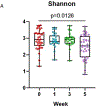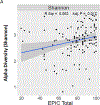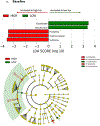Microbial Diversity and Composition Is Associated with Patient-Reported Toxicity during Chemoradiation Therapy for Cervical Cancer
- PMID: 31987960
- PMCID: PMC7932475
- DOI: 10.1016/j.ijrobp.2019.12.040
Microbial Diversity and Composition Is Associated with Patient-Reported Toxicity during Chemoradiation Therapy for Cervical Cancer
Abstract
Purpose: Patients receiving pelvic radiation for cervical cancer experience high rates of acute gastrointestinal (GI) toxicity. The association of changes in the gut microbiome with bowel toxicity from radiation is not well characterized.
Methods and materials: Thirty-five patients undergoing definitive chemoradiation therapy (CRT) underwent longitudinal sampling (baseline and weeks 1, 3, and 5) of the gut microbiome and prospective assessment of patient-reported GI toxicity. DNA was isolated from stool obtained at rectal examination and analyzed with 16S rRNA sequencing. GI toxicity was assessed with the Expanded Prostate Cancer Index Composite instrument to evaluate frequency, urgency, and discomfort associated with bowel function. Shannon diversity index was used to characterize alpha (within sample) diversity. Weighted UniFrac principle coordinates analysis was used to compare beta (between sample) diversity between samples using permutational multivariate analysis of variance. Linear discriminant analysis effect size highlighted microbial features that best distinguish categorized patient samples.
Results: Gut microbiome diversity continuously decreased over the course of CRT, with the largest decrease at week 5. Expanded Prostate Cancer Index Composite bowel function scores also declined over the course of treatment, reflecting increased symptom burden. At all individual time points, higher diversity of the gut microbiome was linearly correlated with better patient-reported GI function, but baseline diversity was not predictive of eventual outcome. Patients with high toxicity demonstrated different compositional changes during CRT in addition to compositional differences in Clostridia species.
Conclusions: Over time, increased radiation toxicity is associated with decreased gut microbiome diversity. Baseline diversity is not predictive of end-of-treatment bowel toxicity, but composition may identify patients at risk for developing high toxicity.
Copyright © 2020. Published by Elsevier Inc.
Conflict of interest statement
Conflict of interest: None
Figures













References
-
- Maruyama Y, Van Nagell JR Jr., Utley J, Vider ML, Parker JC. Radiation and small bowel complications in cervical carcinoma therapy. Radiology. 1974;112(3):699–703. - PubMed
-
- Rotman M, Sedlis A, Piedmonte MR, et al. A phase III randomized trial of postoperative pelvic irradiation in Stage IB cervical carcinoma with poor prognostic features: follow-up of a gynecologic oncology group study. Int J Radiat Oncol Biol Phys. 2006;65(1):169–176. - PubMed
-
- Peters WA 3rd, Liu PY, Barrett RJ 2nd, et al. Concurrent chemotherapy and pelvic radiation therapy compared with pelvic radiation therapy alone as adjuvant therapy after radical surgery in high-risk early-stage cancer of the cervix. J Clin Oncol. 2000;18(8):1606–1613. - PubMed
-
- Keys HM, Roberts JA, Brunetto VL, et al. A phase III trial of surgery with or without adjunctive external pelvic radiation therapy in intermediate risk endometrial adenocarcinoma: a Gynecologic Oncology Group study. Gynecol Oncol. 2004;92(3):744–751. - PubMed
-
- Nout RA, Putter H, Jurgenliemk-Schulz IM, et al. Quality of life after pelvic radiotherapy or vaginal brachytherapy for endometrial cancer: first results of the randomized PORTEC-2 trial. J Clin Oncol. 2009;27(21):3547–3556. - PubMed
Publication types
MeSH terms
Grants and funding
LinkOut - more resources
Full Text Sources
Medical
Research Materials

